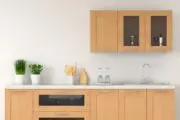
Ah, life in the concrete jungle — where used chewing gum and cigarette butts are a more common sight than butterflies and wildflowers. Indoor plants can certainly help to liven up the décor of a small urban space, but they can also be a bit of a gamble. Will they survive my next business trip? A poorly lit basement apartment? The wrath of my Siamese cat?
To find out the answers to these pressing plant questions, we turned to John Kouwenberg, the owner and operator of Foliera, a tropical plant distributor in Beamsville, Ontario. Together we’ve come up with 6 scenarios and solutions to help you choose an indoor plant that suits your space and lifestyle.
1. If you are terrible at keeping indoor plants alive.

Opt for succulents, says Kouwenberg. “They are definitely trending and require very little water, which is a big deal for people who travel. If you water them once a month it’s probably enough.”
2. If you live in a low-light apartment or condo.
Photo: IKEA
The ponytail palm isn’t actually a palm, but a semi-succulent. “If it’s 20 to 30 feet away from a window, it still does quite well. Again, it also requires very little water so it’s an easy plant to have,” says Kouwenberg.
3. If you’re looking to improve air quality.

Make like Zach Galifianakis and add some ferns. “The crispy wave fern is getting all the hype right now as being the best plant in terms of bettering air quality,” insists Kouwenberg. But if you’re not into the prehistoric look, there are many other houseplants that will purify the air — the more the better!
4. If you want to brighten up a boring balcony.

Some indoor plants can be moved outside during the warmer months. “If you’re looking for something a bit heartier, but you want color and longevity, kalanchoes are a great option,” says Kouwenberg. The tropical, succulent flowering plant can handle the heat and is somewhat drought-tolerant. Crotons will also grow indoors and outdoors, adding height and “tons of color in the foliage” to your balcony or terrace.
5. If you’re a pet owner.

“I’d say cat grass!” jokes Kouwenberg. While most houseplants are harmless, pets can suffer allergic reactions if they ingest toxic flora. Ferns, orchids, African violets, spider plants and areca palms are some safe options.
6. If you want to add color to your space.

“Orchids are a good value, they’ll bloom for three to four months,” says Kouwenberg. Another choice is the bromeliad, a tropical plant that produces a wide array of texture and color. An anthurium will also bring a bit of the tropics into your home with vibrant flower spathes. “They’re pretty tough and can handle a bit of a drought on occasion,” says Kouwenberg.







